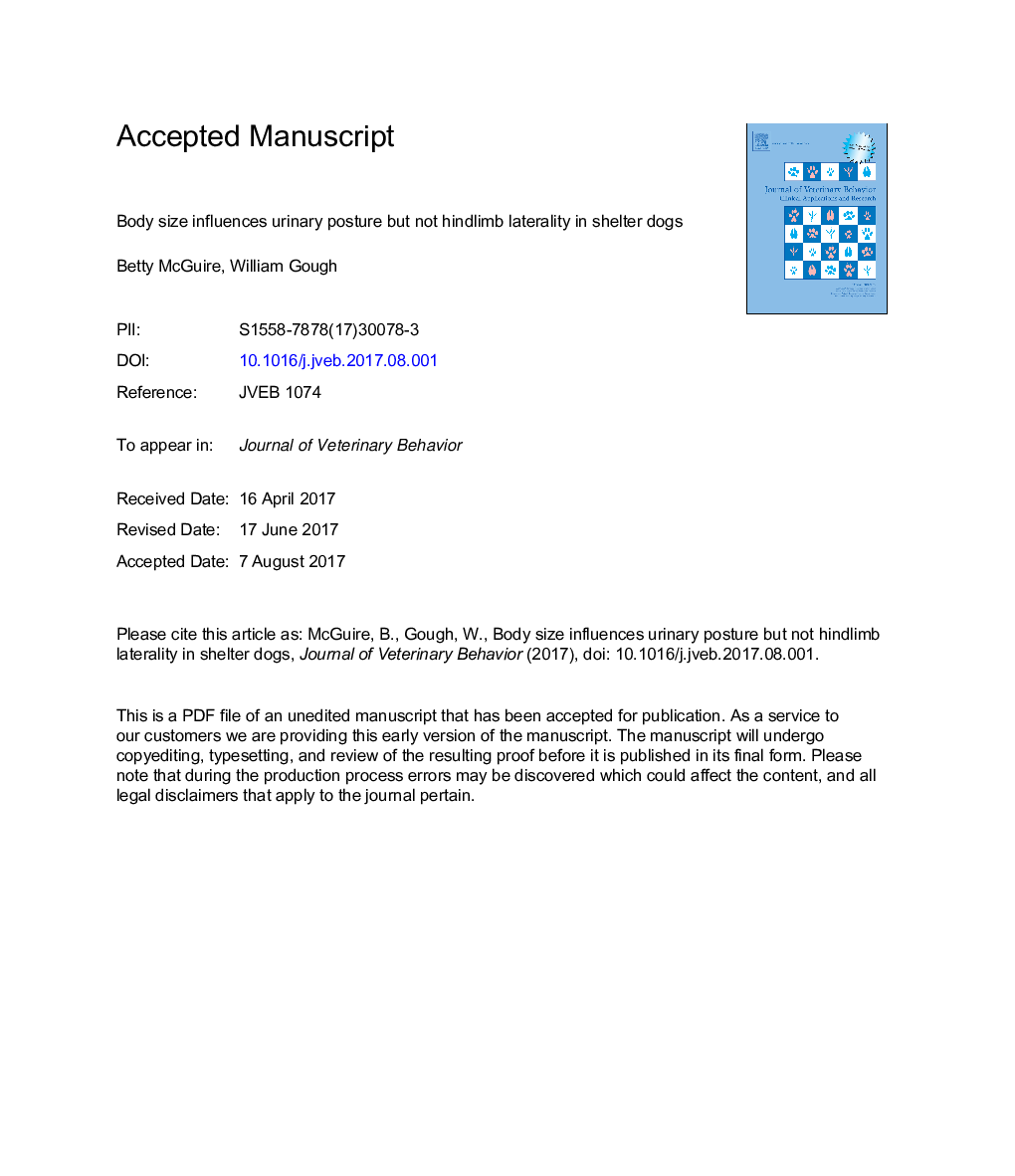| کد مقاله | کد نشریه | سال انتشار | مقاله انگلیسی | نسخه تمام متن |
|---|---|---|---|---|
| 5535974 | 1551595 | 2017 | 32 صفحه PDF | دانلود رایگان |
عنوان انگلیسی مقاله ISI
Body size influences urinary posture but not hindlimb laterality in shelter dogs
ترجمه فارسی عنوان
اندازه بدن بر روی حالت ادراری تأثیر می گذارد، اما در سگ های سرپناه، کمر درد نمی کند
دانلود مقاله + سفارش ترجمه
دانلود مقاله ISI انگلیسی
رایگان برای ایرانیان
کلمات کلیدی
اندازه بدن، سگ، زلزله، پناه، استقرار ادرار، ادرار کردن
موضوعات مرتبط
علوم زیستی و بیوفناوری
علوم کشاورزی و بیولوژیک
علوم دامی و جانورشناسی
چکیده انگلیسی
Motor laterality is the preferential use of structures on one side of the body. Although domestic dogs are commonly used in laterality research, few studies have examined hindlimb motor tasks, and no study, to our knowledge, has examined the effects of body size on measures of laterality. First, we observed 659 dogs during walks at 2 animal shelters to assess likelihood of raising a hindlimb during urination in relation to body size, age class (juvenile, adult, and senior), reproductive status (intact vs. spayed or neutered), shelter, and time spent at shelters; males and females were analyzed separately, and we excluded juveniles from statistical analyses because no female in this age class raised a hindlimb. Second, we observed a subset of the adult and senior dogs (n = 46) over multiple walks to determine if they exhibited side preferences with respect to hindlimb raised during urination. We looked for individual biases and a population bias and analyzed hindlimb preferences with respect to body size. For both males and females, small dogs were more likely than medium and large dogs to raise a hindlimb during urination. Intact males (96%) were more likely than neutered males (83%) to have a predominant urinary posture with a raised hindlimb. Time spent at the shelters influenced urinary posture in mature males: with each additional day spent at the shelter, the odds of a male having a predominant urinary posture with a raised hindlimb increased by 2%. We found the following distribution of hindlimb preferences in the subset of dogs studied for laterality: right preferent, 19.6%; left preferent, 30.4%; and ambilateral, 50.0%. There was no evidence of a population-wide bias for hindlimb raised. Body size did not influence laterality strength or whether a dog was hindlimb preferent (right or left) versus ambilateral. Thus, the likelihood of raising a hindlimb when urinating, but not laterality with respect to hindlimb raised, can be added to the growing list of behavioral differences between small dogs and larger dogs. Previous studies have reported that under stressful conditions, mature male dogs may temporarily revert to the juvenile urinary posture in which no hindlimb is raised. Our finding for adult and senior males that likelihood of raising a hindlimb during urination increased with time spent at the shelters suggests that male urinary posture could potentially serve as a behavioral indicator of adjustment to shelter conditions.
ناشر
Database: Elsevier - ScienceDirect (ساینس دایرکت)
Journal: Journal of Veterinary Behavior: Clinical Applications and Research - Volume 21, SeptemberâOctober 2017, Pages 38-44
Journal: Journal of Veterinary Behavior: Clinical Applications and Research - Volume 21, SeptemberâOctober 2017, Pages 38-44
نویسندگان
Betty McGuire, William Gough,
